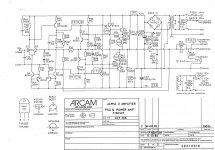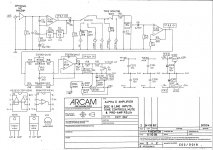Hello!
I have an Arcam Alpha II Amp that has decided to give up the ghost.
BOTH channels are behaving strangely:
Observations:
1) If the preamp stage is connected to the power amp stage then the output transistors get instantly baking hot, (and if left for more than a few seconds will go *pop*).
2) Disconnecting the preamp stage then, no excessive current draw, but -32V appears across each speaker output.
Question is, how do I proceed fault-finding?
TIA,
Andy
I have an Arcam Alpha II Amp that has decided to give up the ghost.
BOTH channels are behaving strangely:
Observations:
1) If the preamp stage is connected to the power amp stage then the output transistors get instantly baking hot, (and if left for more than a few seconds will go *pop*).
2) Disconnecting the preamp stage then, no excessive current draw, but -32V appears across each speaker output.
Question is, how do I proceed fault-finding?
TIA,
Andy
If memory serves, Q6 or Q7 - I think Q7 - in the power amp circuit is next to the heatsink. This often fails. It is the current sink for the VAS transistor Q8 and it's failure to operate drives the outputs to one rail IIRC.
FST239/240 are obsolete, and Arcam replaced them with ZTX653/753.
FST239/240 are obsolete, and Arcam replaced them with ZTX653/753.
@jaycee, Looking at those tranny's next to the heatsink, they are labelled Q6 and Q106.
I guess they are part of a heat compensating circuit... I wonder why they are not therefore actually held onto the heatsinks instead of just being stood right next to the h/s, almost but not quite touching it.
Andy
I guess they are part of a heat compensating circuit... I wonder why they are not therefore actually held onto the heatsinks instead of just being stood right next to the h/s, almost but not quite touching it.
Andy
I can't believe arcam got away with this design. Using the VAS CCS as thermal comp. WOW ! The dual CCS's are cool , like my AX (3mA LTP / 12-14mA VAS current-arcam) but just one more device (a proper Vbe bolted to the heatsink) would go a long way, MTBF wise. 
PS... It would work ,a 2Q ccs has NTC.
OS
PS... It would work ,a 2Q ccs has NTC.
OS
Last edited:
This means from my view unwanted oscillation (checking about oscilloscope).Weird, I've NEVER 'cranked' my amp. God know's why it popped and why BOTH channels exhibit the same failure mode.
Seen it all now!
OK, Q6 appears fine! (just buzzed it only though, lost my damn transistor tester).
ostripper, they got it from the A60 which was designed to a tight budget, in the very early days when everything was expensiveDespite the crudeness they are usually quite reliable, and usually only fail when "cranked"
"Fail when cranked" , what a bummer .... That's the first thing I do on a new design , until the cops come.
OS
the only way is the DC condition testing of each follow sections independently:
1) Power supply without amplifier sections (transformer, rectifier, caps) - cut therefore the pos. and neg. rail and connect parallel to each power cap resistors between 22K and 33K (for discharging after switch off).
2) front end, i. e. diffential LTP amp and VAS stage (disconnect power buffer stage and short the Vbe multiplier, additional connect the NFB-Resistor at the short bridge wire)
3) buffer without short protect and without load (create a new independend Vbe multiplier therefore and check idle current stability)
4) like number three but now with short protect
5) like number four but now with commonly load
6) completly amplifier include front end
Attention !!! If you are beginner, I don't recommend this steps
1) Power supply without amplifier sections (transformer, rectifier, caps) - cut therefore the pos. and neg. rail and connect parallel to each power cap resistors between 22K and 33K (for discharging after switch off).
2) front end, i. e. diffential LTP amp and VAS stage (disconnect power buffer stage and short the Vbe multiplier, additional connect the NFB-Resistor at the short bridge wire)
3) buffer without short protect and without load (create a new independend Vbe multiplier therefore and check idle current stability)
4) like number three but now with short protect
5) like number four but now with commonly load
6) completly amplifier include front end
Attention !!! If you are beginner, I don't recommend this steps
Last edited:
My other guess would be the VAS transistor itself, Q8. I'd imagine this could run fairly hot and die. MPSA56 are still available fortunately. I'd recommend replacing with Onsemi's MPSW56 if you can, it's a TO-92L package and will dissipate heat better.
It might be a good idea to measure the voltages at the indicated test points relative to ground. This would give a good idea whats going on. Also measure on the collectors of Q2, Q3 and Q4.
It might be a good idea to measure the voltages at the indicated test points relative to ground. This would give a good idea whats going on. Also measure on the collectors of Q2, Q3 and Q4.
"Fail when cranked" , what a bummer .... That's the first thing I do on a new design , until the cops come.
OS
This was a mid 70's budget design, as I recall reading (I wasn't alive then!). For the domestic use they would've seen, they worked well
Looking at Left channel to begin with~:
R40 getting hot. Q12 (FST240), upon removal, appears to be OK. D2 OK too.
Will work it back now, if I can get my head around this stuff.
R30 has 1.8V across it... should only be 0.7ish >> Q6 must be at fault... where's that damn transistor tester!
R40 getting hot. Q12 (FST240), upon removal, appears to be OK. D2 OK too.
Will work it back now, if I can get my head around this stuff.
R30 has 1.8V across it... should only be 0.7ish >> Q6 must be at fault... where's that damn transistor tester!
Last edited:
R40 getting hot is expected as Q12 will be hard on (hurr hurr). It might be worth pulling the VI transistors Q9 and Q10, testing them, and seeing how the amp behaves without them (use a bulb limiter in the mains just in case!)
It is also worth noting that on the Alpha III, Arcam replaced Q7 with a BD139, though that amp does also have a higher rail voltage to deal with.
It is also worth noting that on the Alpha III, Arcam replaced Q7 with a BD139, though that amp does also have a higher rail voltage to deal with.
Right, borrowed an AVO meter. Now we'll see...
Cold checked all the semi's and no problem found with leakage, O/C junctions etc... still the power transistors heated up.
Turned the quiescent pot down to zero, this time no heating!
Slowly turned up the current to 7mV across 0R22 and all fine. Power switch turned off then on: immediately power transistors started heating again! Now there was over 300mV.
Long thought....
Checking other channel demonstrated the same problem.
After a while considered the amplifiers were probably going unstable, the 'earth' connection is referenced back through very long track loops. SO disconnected the 'GND' link to C12, C13, R22 and R24 (part of the bias circuit) and referenced it directly to the earth at the centre of D3/D4 C210/C211, (also essential to have a 22k resistor wired from Q2 base to this new temporary ground). Discovered the pot had to be set mechanically higher to reobtain 7mv across 0R22 resistors (?) but more importantly no longer goes into parasitic oscillation when first powered on!!!!!
A classic ground loop problem and this is the original Arcam design too! To be honest it's poor as the quiescent current is affected by whatever signal currents are on the GND line.
Now I'm wondering what I've done to the amp to suddenly 'create' this problem, where it didn't exist before!
Thanks again,
Andy
Cold checked all the semi's and no problem found with leakage, O/C junctions etc... still the power transistors heated up.
Turned the quiescent pot down to zero, this time no heating!
Slowly turned up the current to 7mV across 0R22 and all fine. Power switch turned off then on: immediately power transistors started heating again! Now there was over 300mV.
Long thought....
Checking other channel demonstrated the same problem.
After a while considered the amplifiers were probably going unstable, the 'earth' connection is referenced back through very long track loops. SO disconnected the 'GND' link to C12, C13, R22 and R24 (part of the bias circuit) and referenced it directly to the earth at the centre of D3/D4 C210/C211, (also essential to have a 22k resistor wired from Q2 base to this new temporary ground). Discovered the pot had to be set mechanically higher to reobtain 7mv across 0R22 resistors (?) but more importantly no longer goes into parasitic oscillation when first powered on!!!!!
A classic ground loop problem and this is the original Arcam design too! To be honest it's poor as the quiescent current is affected by whatever signal currents are on the GND line.
Now I'm wondering what I've done to the amp to suddenly 'create' this problem, where it didn't exist before!
Thanks again,
Andy
- Status
- This old topic is closed. If you want to reopen this topic, contact a moderator using the "Report Post" button.
- Home
- Amplifiers
- Solid State
- Help! Repairing Arcam Alpha II

